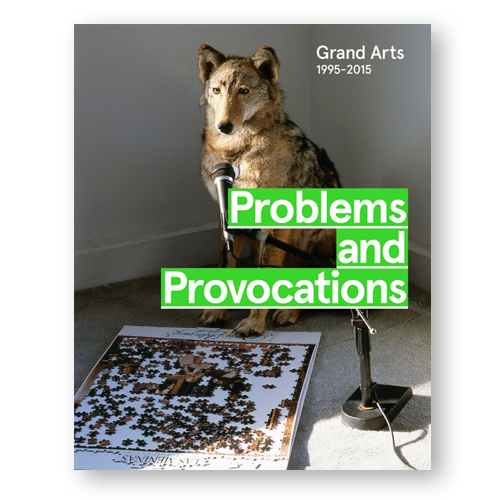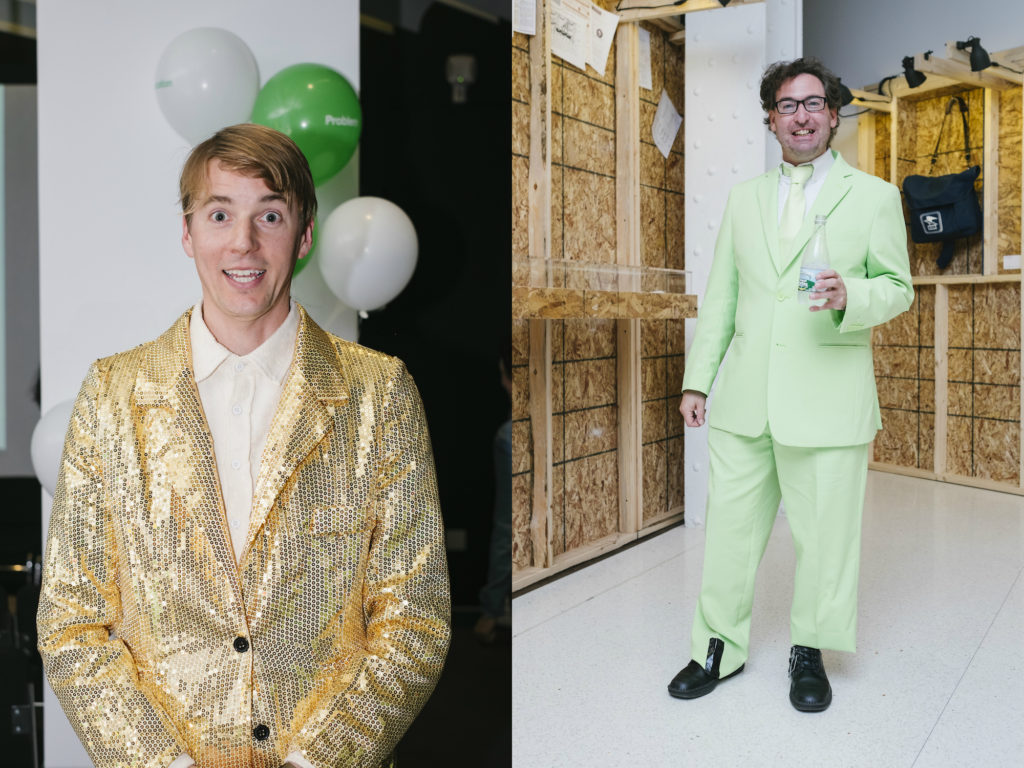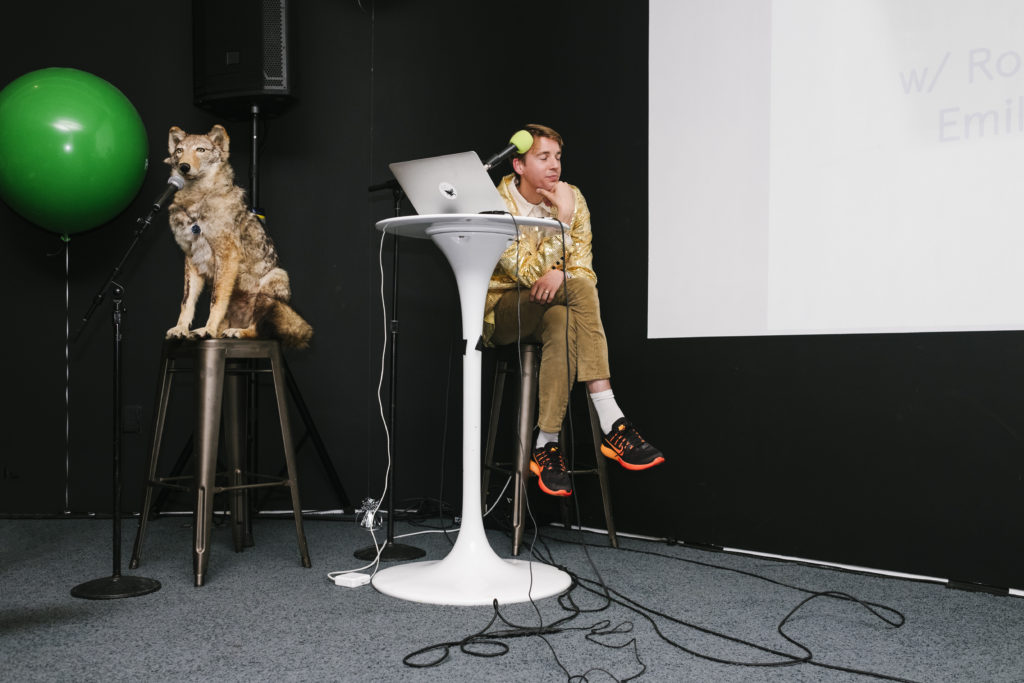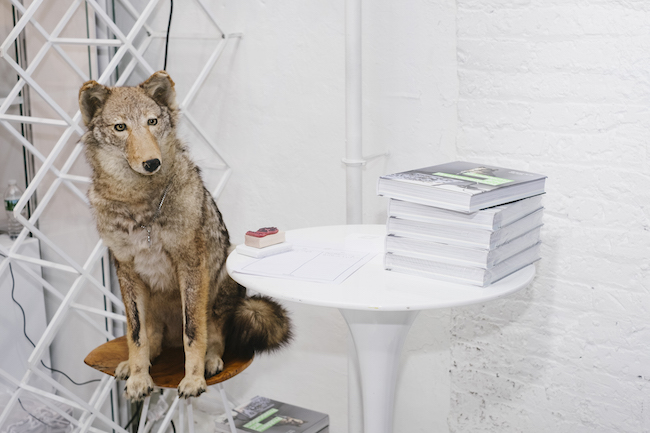By Alina Cohen
A few days before the Problems and Provocations book launch, Stacy Switzer mused that the promotional materials somewhat misrepresented the nature of the event. “They’ve been saying panel discussion, but it’s not really a panel discussion,” she told me by phone. “It’s framed as more of a variety show.” Switzer is the former artistic director of Kansas City-based Grand Arts, a contemporary art project space that closed in 2015. Problems and Provocations, which she and collaborator Annie Fischer edited, celebrates the organization’s mission and projects throughout its 20 years of operation in pages both commemorative and absurd. Given the unconventional, expansive nature of Grand Arts’ work and the new book, a simple panel discussion just wouldn’t be fitting.

Switzer was calling from Los Angeles, where she recently relocated from Kansas City. Along with a handful of former Grand Arts collaborators, she’s in the process of developing Fathomers, which bills itself as a “philanthropic research institute that convenes radical thinkers across disciplines to create new worlds together.” The team is currently working with artist Michael Jones McKean (who was also a collaborator at Grand Arts), on a long-term project. In 1969, amateur sailor Donald Crowhurst unsuccessfully attempted to sail around the world, and his boat, the Teignmouth Electron, washed ashore in the Caribbean. McKean purchased the ship and is in the process of 3-D scanning the remains for future fossilization.
“Problems and Provocations is designed to capture the energetic spirit of dreaming things into being, of forming our own ‘now,’ of being generous with ideas as well as mistakes, so that others might learn alongside us,” Switzer writes in her introduction. Images and archival material from Grand Arts’ projects comprise a majority of the book, the rest of which is made up of artist essays and perspectives. The volume ends with a timeline and a section entitled “The Devil’s Dictionary, n.,” described as “a group effort to rescue words from Webster’s and give them fresher, more precise definitions for their latest now.” Some definitions consist of photographs or drawings. Others are merely apt re-imaginations of familiar words: accident, n. / An opportunity for a lawyer; patriarch, n. / A pelvis so proud of its gyrations, it picks up the tab at dinner; healing, n. / The act or process of making the same mistakes over and over, but each time the mistake becomes more obvious, more quickly, and so the agony of its aftermath is of shorter and shorter duration. The Dictionary exemplifies Grand Arts’ ambitions to reframe thinking about even the most widely accepted elements of our lives.
Grand Arts functioned as a subversive cultural center in Kansas City from 1995-2015, and Switzer came on board as Artistic Director in 2004. After completing graduate work at the School of the Art Institute of Chicago, she took a job at Salina Art Center in Salina, Kansas. During her three and a half years there, she says she “visited Grand Arts as often as [she] could because it was clear that it was a really important place for artists, and it was always the place where the most interesting and exciting shows were happening in the region.” The organization enjoyed a national and international reputation for helping artists realize their dream projects.
“When I applied for the job, I thought it was a long shot,” Switzer said. “I was thrilled to get it and dove right in.” She first devoted her efforts to working with Bronx-based artist Rosemarie Fiore, whose Good-Time Mix Machine: Scrambler Drawings ran from September 3 through October 23, 2004. Fiore’s online biography states: “She typically produces artwork out of the actions of mechanisms by converting popular technology such as lawn mowers, cars, waffle irons, floor polishers, pinball machines, fireworks and amusement park rides into painting machine.” Problems and Provocations neatly sums up her work: “Today we’d call it ‘hacking’ — but it has long been a universally understood variety of fun.” The book articulates, through commentary and images of Fiore’s preliminary drawings and finished product, how the artist set up a 1964 Eli Bridge Scrambler (the dizziness-inducing amusement park ride) in a warehouse and attached spray mechanisms to the seats. When Fiore and the staff turned on the ride, it sprayed paint onto a white sheet, and produced a shape much like that created by a Spirograph. “In borrowing a machine, then, that so directly evokes the exhilarating pleasures of childhood, Fiore made a seriously fun decision. What a ride,” writes contributor Rob Walker.
Problems and Provocations honors a set of works diverse in their materials, underlying themes, and creators. The book, starting with the title itself, emphasizes the challenges and questions raised by each. Grand Arts’ ability to troubleshoot strange new difficulties becomes a cohesive thread. An email from a Grand Arts staff member regarding Anthony Baab’s A Strenuous Nonbeing (2013) reads: “Remind me, did we determine whether this was viable?” In an email from Switzer to artist Sissel Tolaas about her SmellScape KCK/KCMO (2012), she writes about the difficulties of obtaining written permission to use a public park. John Salvest’s New Cornucopia and the Big IOU (2011) — a nearly seven-story high public sculpture just outside the Federal Reserve Bank of Kansas City composed of 105 steel shipping containers — faced opposition from shipping container companies, the parks department, and the Federal Reserve.
Switzer spoke with more enthusiasm than annoyance about the biggest challenges she and her team faced, as though the wild tribulations and the ability to prove naysayers wrong were just part of the fun. She cited The Propeller Group’s A Universe of Collisons (2015) as a particularly tricky piece. Based in Ho Chi Minh City, the group creates work about the Cold War, “and around different types of violence and trauma and memory,” according to Switzer. After a visit to a Civil War Museum, the team became captivated by the idea of bullet collisions. “It was like this beautiful, poetic object that captured the sort of lethal force that had been arrested, just by chance,” Switzer recalled. The Propeller Group wanted to purchase guns to simultaneously fire across from each other, creating their own new objects from weapons intended to destroy. There were the obvious problems (Switzer said: “How do you not destroy the guns as you’re firing them at each other, and how do you keep everyone safe?”) as well as the unforeseen. Grand Arts had to get a permit from the State Department, because though two of the three Propeller Group members were born in the United States, they were still considered “Vietnamese persons” under US law, and at the time, an embargo prevented Americans from sharing militarized technology with Vietnamese people. This also complicated their ability to go to a ballistics lab, a necessary step in their artistic process. “Even though guns are easier to acquire than they should be, the idea that these artists from Vietnam were going to come to this ballistics lab and potentially get some kind of inside information had to be vetted through the State Department,” Switzer said.
In his essay at the beginning of the book, Rob Walker writes extensively about the regulatory and legal challenges involved in many of the Grand Arts projects. A Universe of Collisions marked the final show at Grand Arts. “It’s tempting to frame a poetic connection between this final show and the history of Grand Arts in terms of impact,” writes Walker. “But I’d rather suggest a connection through the idea of trajectory — a word that captures momentum, purposeful motion over time.” Walker ends his essay midsentence. Grand Arts’ work is far from finished.

How, then, does a group of people who facilitated the purchase of an amusement park ride, wrangled with the State Department and the Federal Reserve, and created their own dictionary launch a book and reinvigorate the tired panel discussion format? Answer: with balloons, a taxidermy coyote, some angry singing, and presenters in gold and lime green suits.
In the back of Red Bull Studios, a project and event space in Chelsea, green and white balloons greeted an expansive audience — the crowd swelled far behind the seating area, peering in from the hallway. Avant-garde tour guide Timothy “Speed” Levitch emceed the program in a bright lime suit, while Eric Dobbins, in a shimmering gold jacket, served as the evening’s “Table of Contents,” clicking through Powerpoint slides. A taxidermy coyote called Florence sat on a stool in front of Dobbins. Florence, apparently, serves as the Director of Public Relations at the Homeless Museum of Art in Brooklyn. With the help of Grand Arts, Filip Noterdaeme attempted to set up a similar museum in Kansas City. It’s the only unrealized project in the book. She also adorns the cover of Problems and Provocations.

Artist Mel Chin, who worked with Grand Arts in the past, performed an angry rendition of a Lead Belly song as a tribute to the Black Lives Matter movement. In the only real “panel discussion” portion of the evening, scholar, critic, and curator Maria Buszek asked four artists involved with Grand Arts about their experiences. Levitch read from his favorite essays, and along with two former Grand Arts artists, read definitions from the Devil’s Dictionary. McKean spoke about his work with Grand Arts and its afterlife with Fathomers. “The DNA of Fathomers seems like ‘okay, we’re going to commit to artists, think through a set of problems, and commit to their practice,’” he told me after the program. “It seems like an incredible opportunity to actually scale a set of queries up and figure out how they might grow.” The spirit of Grand Arts isn’t disappearing — just morphing into something new.
“The Problems and Provocations book was Grand Arts’ final endeavor, so I kind of was thinking of this show as a vaudeville celebration of that retrospective,” Levitch told me after the program. He handed me a handmade invitation on recycled cardboard for a monologue he’ll deliver next month at the Subculture space on Bleeker Street. The back read: “80s New Wave / Synth / Industrial / Goth / ft Star Eyes / Jeffo! / Andi Synthicide / Hosted by / Mother Angel Blue.” On the front, he’d highlighted WHERE, WHEN, and Tix Available Here (subculturenewyork.com, should you be free on November 2nd). Levitch bounces back and forth between Kansas City and New York, giving unconventional tours. He participated in a few of the Grand Arts projects throughout their tenure, including as a tour guide for SmellScape, which captured scents around Kansas City. Of the smells, he recalls, “there really was some grotesque ones we made to include in the Baskin Robbins of it.” He particularly enjoyed the scent of the laundromat.

Photography by Donald Stahl. Images courtesy of Red Bull Studios New York.


